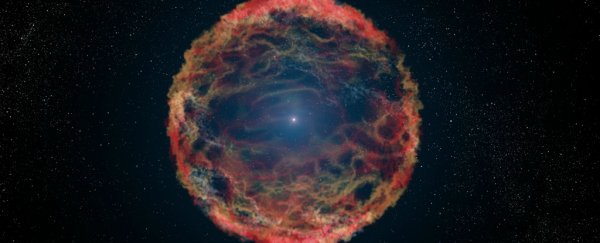An international team of astronomers working with the Gran Telescopio Canarias in Spain say they have witnessed the same superluminous supernova explode twice.
The supernova went from bright to dim two times – instead of just once, which was what the researchers expected.
The team says this double-whammy explosion is likely the result of a magnetar – a rapidly rotating neutron star that forms after a gigantic stars collapses.
Their findings shed new light on these superluminous supernovae, or SLSNs, pushing astronomers closer to a complete model of how they operate.
"From our data, we have tried to determine if this is a characteristic unique to this object, or whether it is a common feature of all superluminous supernovae, but has not been observed before, which is perfectly possible given their unpredictable nature," team leader Mathew Smith, from the University of Southampton in the UK, said in a statement.
SLSN are much bigger than the other types of supernovae that researchers typically observe, which are categorised by how much light they give off.
For example, one of the most commonly seen types is called Ia, which form within binary systems and usually appear very bright for a few weeks before burning out completely. SLSN, on the other hand, are even brighter and can stay bright for up to six months.
This isn't the first time researchers have been shocked by SLSNs, though. Back in January, a team of astronomers working with the Las Campanas Observatory in Chile witnessed one of the biggest SLSNs ever recorded, which they said was over 200 times more powerful than any on record.
Despite the amazing show they put on in the night sky, researchers have only witnessed about 12 of them, meaning there isn't a lot of data about how they work.
The new study is the first to observe a SLSN from the moment it exploded to the moment it died out, allowing researchers to witness every detail.
"Superluminous supernovae are up to a hundred times more energetic than type 1a supernovae because they can remain bright for up to six months before fading, rather than just a few weeks," Smith said.
"What we have managed to observe, which is completely new, is that before the major explosion, there is a shorter, less luminous outburst, which we can pick out because it is followed by a dip in the light curve, and which lasts just a few days."
The celestial object the team studied is known to astronomers as DES14X3taz, which lies 6,400 light-years away and was originally discovered by astronomers working with the Dark Energy Survey back in December 2014.
After that team pegged the object as a possible SLSN, the current team used the GTC to monitor its activity on 26 January 2015 and again on 6 February 2015, witnessing a strange dip in brightness that makes it appear that the supernova happened twice, an event that researchers previously thought couldn't occur.
"From our data, we have tried to determine if this is a characteristic unique to this object, or whether it is a common feature of all superluminous supernovae, but has not been observed before, which is perfectly possible given their unpredictable nature," Smith said.
To study the weird phenomenon, the team analyses the data they collected with computer models to see if any lined up with what they saw. In the end, they concluded that the double rise in brightness was likely caused by the formation of a magnetar, an awesomely named neutron star that rotates very quickly, becoming bright as it grows in size. As Smith explains:
"We think that a very massive star, some 200 times the mass of the Sun, collapses to form a magnetar. In the process, the first explosion occurs, which expels into space a quantity of matter equivalent to the mass of our sun, and this gives rise to the first peak of the graph.
The second peak occurs when the star collapses to form the magnetar, which is a very dense object rotating rapidly on its axis, and which heats up the matter expelled from the first explosion. This heating is what generates the second peak in the luminosity."
The team's findings shed new light on how SLSNs form and die out, providing possible data for future studies that will – hopefully – lead to a complete model of the strange supernovae.
The new findings were recently published in the journal The Astrophysical Journal Letters.
